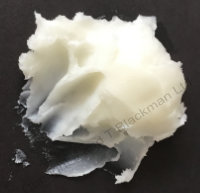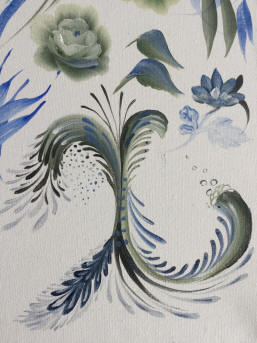 |
Cold Wax Painting Medium |
|
 |
Cold Wax Painting Medium |
|
Brushable and LiquiBlend Wax Inspirations.
A few different way to use the Brushable and LiquiBlend Wax
|
Brushable Wax Resist inspiration. In the image top right the Brushable Wax Resist has been coloured with a small amount of oil paint. It was applied in a random way, using a painting knife, to the surface of a sheet of Yupo paper. A clean sheet of paper was laid on top of the applied wax. Using your hand or a roller, apply pressure to the surface to move the wax around. When the sheet of paper is lifted off you have a mono print, usually of an abstract nature, that you can embellish further or leave as is. Depending how much Brushable Wax Resist was applied to the Yupo, further 'prints' can be obtained. Each will be softer in colour as the wax is removed by each sheet. Allow to dry if the print is the desired finish, or manipulate the wax by adding more, or brushing it out or adding metallic powders and such like. If watercolour paper is used then the Wax Resist will come into its own as water colour effects are applied to the surface. |
|
|
|
Dendritic patterns. Looking around the net you will find plenty of information about making 'dendritic' mono prints. Dendritic and dendrite relate to 'branched' or 'branching' like a tree and to the way crystals grow in a branch like fashion. Most of these mono prints are made by applying the paint to glass, but if you use something like Yupo paper, as described above, you can even use the paper after the prints have been taken and less cleaning-up to do! Image left is a 'dendritic' or branch like pattern produced from the Brushable Wax Resists used above. |
| LiquiBlend and Wax Pencil Take a sheet of printer type paper and using Drawing Ink A/Indian Ink apply a design to the surface. Allow the ink to dry. Cover the sheet with LiquiBlend Wax by brushing or 'polishing' it over the surface, this will give the paper a 'parchment' look which will remain when dry. Using coloured pencils you can now colour the design, the LiquiBlend will allow the coloured pencils to be blended, especially wax ones. Coloured pencils needing water are not suitable for this technique. For best results complete the pencil work whilst the LiquiBlend Wax is still soft/wet, once dry the surface can be buffed with a lint free cloth. |
Blended on the left-hand side of the image. |
|
|
LiquiBlend or Brushable Wax Resist and Metallic powders. Make an easy to apply metallic paint. Metallic powders and bronzing powders can be mixed with LiquiBlend to give an excellent painting medium. LiquiBlend retains the colour of the metal look of the powder and prevents it tarnishing. It can be applied with a brush or painting knife. If you want a thicker consistency than that produced by LiquiBlend then the option would be to mix with Cold Wax Painting Medium. Can be used on paper, canvas or chosen surface. |
|
LiquiBlend for Tole painting. In the example (testing with a bit of leftover paint) canvas on the right the oil paint was mixed with the LiquiBlend. This mix gives a paint thin enough to flow from the brush, which dries to a soft sheen on its surface. It was a thin mixture and gives a transparent look 'almost a watercolour feel' to the finished examples, a much lighter look than normally associated with oil paint. The painting was touch dry the next day in the thinly painted areas, the thicker areas were dry the following day. Both flat and round brushes were tested using the' Liqui' paint, long smooth strokes, short stippling strokes and numerous leaf and comer strokes. Double loading was tested as was over painting, paint applied on top of already applied paint. The brush marks retained their shape and the colour stayed true and didn't sag or meld together. I have painted and taught Tole painting using oils, on and off, for many years and I enjoy oils. But I have to say, the 'paint' made with the LiquiBlend was a joy to use, it flowed well and was easy to double load and paint that way. It gave a slightly different 'look' to the finish and the result. It was quick drying and clean-up was easy. LiquiBlend could be useful to expand you repertoire. If you see this information anywhere else, then you know it has been plagiarised. Copyright © Jacqui Blackman 2016 |
 LiquiBlend and oil paint mixed for this test on canvas. |
Do you read 'blogs' try - the false information about Zest-it Cold Wax Painting Medium
Ancillary Tools | Cold Wax Painting Medium | Wax Solvent
Copyright 2001 - 2025 © Jacqui Blackman. All Rights Reserved
Worldwide.
The information contained herein is the Intellectual Property of
Jacqui Blackman and
J. & T. Blackman Ltd., and is supplied without liability for
errors or omissions.
Zest-it ® and its ![]() logo are Registered Trademarks.
logo are Registered Trademarks.
No part may be reproduced or used except as authorized by
contract or other written permission, unless stated otherwise.
The copyright and the foregoing restriction on reproduction and
use extend to all media in which the information may be embodied.